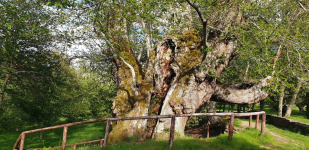BrianBay9
Masterpiece
Last edited:
I love the leaves on it, be a nice hollow tree candidate if it were mine perhaps.

This might be a bit of inspiration for you Brian.
View attachment 567055
I believe that was the Laund oak in Bolton Abbey, in the UK, Europe has a lot of ancient trees surprisingly since most of the forests have been cut long ago.Oooo. Where is that?

Thanks for the carving tip. I like the suggestion.Well done on the carving. I like the connectivity between the primary carved areas. We’ll thought out. The carving will weather up nicely as it is exposed to the CA heat, sun and watering.
Just for consideration. I’d try to connect the Uro to the center of the point where a branch/trunk-section once lived and grew. A nice natural weather-worn deteriorated area. It’s an opportunity to undercut behind the wood to create a dimensional area with some light that could show through from the back hole. This is a practice I need to learn more about and practice on my trees.
Excellent work on the tree with a great deal of weathered character. Mighty fine!
Please keep posting progress. The photos are inspirational.
